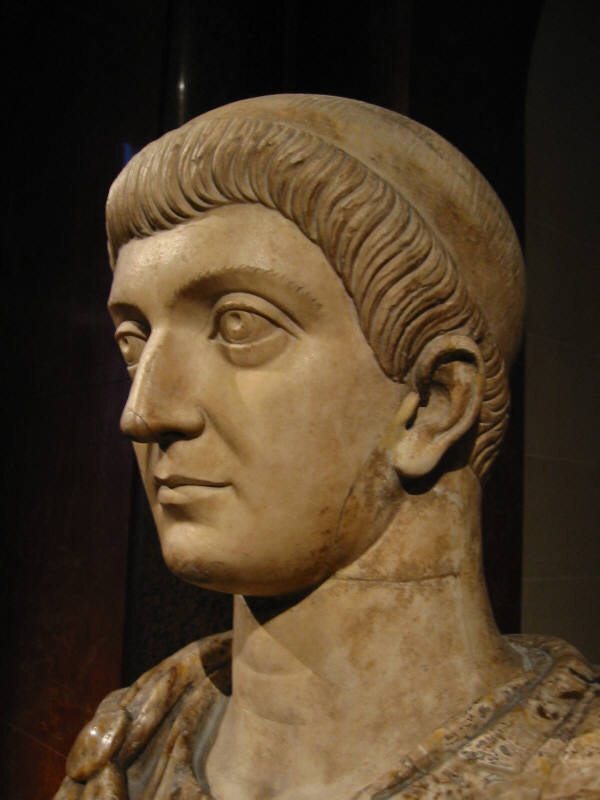NGC MS 5/5 - 3/5 Constantine I the Great (AD 307-337). AE3 or BI nummus , Rome, 2nd officina, AD 329-330. CONSTANTI-NVS MAX AVG, rosette-diademed, draped and cuirassed bust of Constantine I right / D N CONSTANTINI MAX AVG, legend surrounding wreath terminating in large jewel enclosing VOT / • / XXX; RFS in exergue. RIC VII 322.
From the Epfig Hoard
 |
Constantine I (27 February c. 272 – 22 May 337), also known as Constantine the Great, was a Roman emperor from AD 306 to 337 and the first Roman emperor to convert to Christianity. He played a pivotal role in elevating the status of Christianity in Rome, decriminalizing Christian practice and ceasing Christian persecution in a period referred to as the Constantinian shift.[4] This initiated the cessation of the established ancient Roman religion. Constantine is also the originator of the religiopolitical ideology known as Constantinianism, which epitomizes the unity of church and state, as opposed to separation of church and state. He founded the city of Constantinople and made it the capital of the Empire, which remained so for over a millennium.
Born in Naissus, Dacia Mediterranea (now Niš, Serbia), he was the son of Flavius Constantius, a Roman army officer of Illyrian origin who had been one of the four rulers of the Tetrarchy. His mother, Helena, was a Greek woman of low birth, probably from Asia Minor in modern Turkey. Later canonised as a saint, she is traditionally credited for the conversion of her son. Constantine served with distinction under the Roman emperors Diocletian and Galerius. He began his career by campaigning in the eastern provinces (against the Persians) before being recalled in the west (in AD 305) to fight alongside his father in the province of Britannia. After his father's death in 306, Constantine was proclaimed as augustus (emperor) by his army at Eboracum (York, England). He eventually emerged victorious in the civil wars against emperors Maxentius and Licinius to become the sole ruler of the Roman Empire by 324.
Upon his ascension, Constantine enacted numerous reforms to strengthen the empire. He restructured the government, separating civil and military authorities. To combat inflation, he introduced the solidus, a new gold coin that became the standard for Byzantine and European currencies for more than a thousand years. The Roman army was reorganised to consist of mobile units (comitatenses), often around the Emperor, to serve on campaigns against external enemies or Roman rebels, and frontier-garrison troops (limitanei) which were capable of countering barbarian raids, but less and less capable, over time, of countering full-scale barbarian invasions. Constantine pursued successful campaigns against the tribes on the Roman frontiers—such as the Franks, the Alemanni, the Goths, and the Sarmatians—and resettled territories abandoned by his predecessors during the Crisis of the Third Century with citizens of Roman culture.
Although Constantine lived much of his life as a pagan and later as a catechumen, he began to favour Christianity beginning in 312, finally becoming a Christian and being baptised by Eusebius of Nicomedia, an Arian bishop, although the Catholic Church and the Coptic Orthodox Church maintain that he was baptised by Pope Sylvester I. He played an influential role in the proclamation of the Edict of Milan in 313, which declared tolerance for Christianity in the Roman Empire. He convoked the First Council of Nicaea in 325 which produced the statement of Christian belief known as the Nicene Creed. The Church of the Holy Sepulchre was built on his orders at the purported site of Jesus' tomb in Jerusalem and was deemed the holiest place in all of Christendom. The papal claim to temporal power in the High Middle Ages was based on the fabricated Donation of Constantine. He has historically been referred to as the "First Christian Emperor", but while he did favour the Christian Church, some modern scholars debate his beliefs and even his comprehension of Christianity.[i] Nevertheless, he is venerated as a saint in Eastern Christianity, and he did much to push Christianity towards the mainstream of Roman culture.
The age of Constantine marked a distinct epoch in the history of the Roman Empire and a pivotal moment in the transition from classical antiquity to the Middle Ages. He built a new imperial residence in the city of Byzantium and renamed it New Rome, later adopting the name Constantinople after himself, where it was located in modern Istanbul. It subsequently became the capital of the empire for more than a thousand years, the later Eastern Roman Empire often being referred to in English as the Byzantine Empire, a term never used by the Empire, invented by German historian Hieronymus Wolf. His more immediate political legacy was that he replaced Diocletian's Tetrarchy with the de facto principle of dynastic succession by leaving the empire to his sons and other members of the Constantinian dynasty. His reputation flourished during the lifetime of his children and for centuries after his reign. The medieval church held him up as a paragon of virtue, while secular rulers invoked him as a prototype, a point of reference, and the symbol of imperial legitimacy and identity. At the beginning of the Renaissance, there were more critical appraisals of his reign with the rediscovery of anti-Constantinian sources. Trends in modern and recent scholarship have attempted to balance the extremes of previous scholarship.










